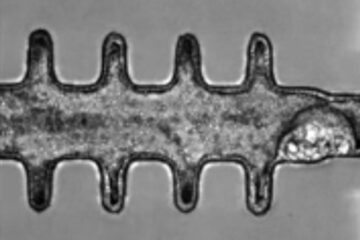Researchers demonstrate single molecule absorption spectroscopy

A powerful new tool for probing molecular structure on surfaces has been developed by researchers at the University of Illinois at Urbana-Champaign. Single molecule absorption spectroscopy can enhance molecular analysis, surface manipulation and studies of molecular energy and reactivity at the atomic level.
“This new measurement method combines the chemical selectivity of optical absorption spectroscopy with the atomic-scale resolution of scanning tunneling microscopy,” said Martin Gruebele, a professor of chemistry, physics and biophysics and corresponding author of a paper accepted for publication in the journal Nano Letters, and posted on its Web site. “The method literally feels how a molecule changes shape when it absorbs energy.”
Unlike single molecule fluorescence spectroscopy, which is now a commonly used measurement technique, single molecule absorption spectroscopy has been an elusive goal.
“Single molecules don’t absorb much light, making detection difficult to begin with,” said Gruebele, who also is a researcher at the university’s Beckman Institute for Advanced Science and Technology. “An even bigger problem, however, is that light-induced heating in the sample and in the microscope tip can produce so much noise that the signal is lost.”
To reduce the noise, the researchers combined several special techniques — each insufficient by itself — into a method that allows them to detect single molecule absorption under laser illumination by scanning tunneling microscopy.
“First, the sample molecule is placed on a transparent silicon substrate,” said Joseph Lyding, a professor of electrical and computer engineering and a researcher at the Beckman Institute. “Laser light will either be absorbed by the sample or will pass through the substrate with little or no heating effect. Second, the tip-sample junction is illuminated through the rear face of the substrate, significantly reducing tip heating.”
Modulating the laser light with a mechanical chopper further reduces heating, Lyding said. A lock-in amplifier, which switches on and off at the same rate as the laser, filters out mechanical and electronic noise. As a result, the absorbed energy causes a change of shape in the electron density of the sample molecule, and the scanning tunneling microscope then measures that change of shape.
“Single molecule absorption spectroscopy is an extremely sensitive technique for analytical chemistry, for measuring electrical properties of molecules, and for studying energy transfer on surfaces,” Gruebele said. “While most molecules don’t fluoresce — limiting the usefulness of single molecule fluorescence spectroscopy — all molecules absorb, making single molecule absorption spectroscopy a much more general approach.”
Media Contact
More Information:
http://www.uiuc.eduAll latest news from the category: Physics and Astronomy
This area deals with the fundamental laws and building blocks of nature and how they interact, the properties and the behavior of matter, and research into space and time and their structures.
innovations-report provides in-depth reports and articles on subjects such as astrophysics, laser technologies, nuclear, quantum, particle and solid-state physics, nanotechnologies, planetary research and findings (Mars, Venus) and developments related to the Hubble Telescope.
Newest articles

Solving the riddle of the sphingolipids in coronary artery disease
Weill Cornell Medicine investigators have uncovered a way to unleash in blood vessels the protective effects of a type of fat-related molecule known as a sphingolipid, suggesting a promising new…

Rocks with the oldest evidence yet of Earth’s magnetic field
The 3.7 billion-year-old rocks may extend the magnetic field’s age by 200 million years. Geologists at MIT and Oxford University have uncovered ancient rocks in Greenland that bear the oldest…

Mini-colons revolutionize colorectal cancer research
As our battle against cancer rages on, the quest for more sophisticated and realistic models to study tumor development has never been more critical. Until now, research has relied on…





















